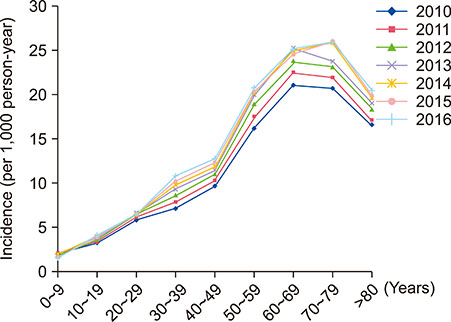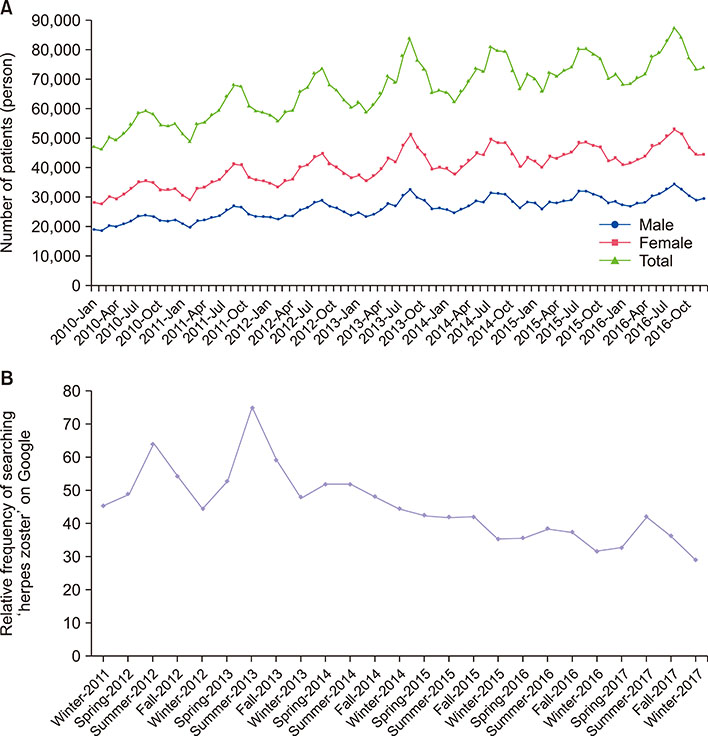Ann Dermatol.
2019 Aug;31(4):486-488. 10.5021/ad.2019.31.4.486.
Population-Based Epidemiologic Study on Herpes Zoster in Korea: Seven-Year Nationwide Analysis from 2010 to 2016
- Affiliations
-
- 1Department of Dermatology, Seoul National University College of Medicine, Seoul, Department of Dermatology, Seoul National University Bundang Hospital, Seongnam, Korea. gcpark@snu.ac.kr
- KMID: 2451496
- DOI: http://doi.org/10.5021/ad.2019.31.4.486
Abstract
- No abstract available.
MeSH Terms
Figure
Reference
-
1. Levin MJ. Immune senescence and vaccines to prevent herpes zoster in older persons. Curr Opin Immunol. 2012; 24:494–500.
Article2. Yawn BP, Gilden D. The global epidemiology of herpes zoster. Neurology. 2013; 81:928–930.
Article3. HIRA. Statistical information-open system for health and medical big data [Internet]. cited 2018 Mar 3. Available from: https://opendata.hira.or.kr.4. Choi WS, Noh JY, Huh JY, Jo YM, Lee J, Song JY, et al. Disease burden of herpes zoster in Korea. J Clin Virol. 2010; 47:325–329.
Article5. Wu PY, Wu HD, Chou TC, Sung FC. Varicella vaccination alters the chronological trends of herpes zoster and varicella. PLoS One. 2013; 8:e77709.
Article6. Ogunjimi B, Van den, Meysman P, Heynderickx S, Bergs K, Jansens H, et al. Multidisciplinary study of the secondary immune response in grandparents re-exposed to chickenpox. Sci Rep. 2017; 7:1077.
Article7. Kim YJ, Lee CN, Lim CY, Jeon WS, Park YM. Populationbased study of the epidemiology of herpes zoster in Korea. J Korean Med Sci. 2014; 29:1706–1710.
Article8. Zak-Prelich M, Borkowski JL, Alexander F, Norval M. The role of solar ultraviolet irradiation in zoster. Epidemiol Infect. 2002; 129:593–597.
Article9. Kim YS, Seo HM, Bang CH, Lee JH, Park YG, Kim YJ, et al. Validation of herpes zoster diagnosis code in the electronic medical record: a retrospective, multicenter study. Ann Dermatol. 2018; 30:253–255.
Article
- Full Text Links
- Actions
-
Cited
- CITED
-
- Close
- Share
- Similar articles
-
- Herpes Zoster Treated with Vidarabine-5-Monophosphate
- Ophthalmoplegia in Herpes Zoster Ophthalmicus
- A Case of Herpes Zoster Multiplex in Five Disparate Dermatomes
- Herpes zoster duplex bilateralis in bortezomib-based chemotherapy
- A Case of Herpes Zoster Duplex Bilateralis, a Diagnostic Clue of Human Immunodeficiency Virus Infection



